Abstract
Vibrations occurring during road transport can vary in a wide spectrum and they can lead to losses in quality of transported materials. However, the vibrations are definitely different than the loads experienced by pellet samples in the tester used for durability tests according to the standard ISO 17831-1. The aim of the study was to evaluate the durability of wood biomass pellets available for sale in large-area stores, in terms of loads occurring in transport. The durability of the pellets was tested by subjecting them to vertical and horizontal vibrations similar to those occurring during local transport of this type of fuel for the needs of households. Durability tests were also carried out in accordance with ISO 17831-1. The results were analyzed statistically. Among other, it was found that the vibration time impact on the tested pellet durability was significantly lower in case of horizontal vibrations than in vertical. Moreover, pellets with a diameter of 8 mm showed lower durability than pellets with a diameter of 6 mm. Durability tests carried out in accordance with ISO 17831-1 showed lower pellet strength results compared to the test methods based on lateral and vertical vibrations.
1. Introduction
When analyzing the issue of pellet durability, this concept should also be defined. Durability is a quality feature that belongs to the mechanical parameters of solid fuels. It is also the main physical quality parameter considered by industry [1]. It can be defined as the resistance of the fuel to shocks or abrasion generated during the processes related to distribution and transport. According to the definition given by [2] mechanical durability means the ability of pellets to withstand destructive loads and forces during transportation, storage and handling.
Low pellet durability is not desirable, because, as it was mentioned earlier—if the pellet crumbles easily, may cause problems of dirt in the stove, cause disturbances within automatic pellet feeding systems; it may be also problems of reduced combustion efficiency and increased emissions [1,3,4]. It can also cause an increased risk of fire explosion during pellet handling and storage [2,4,5,6].
Mechanical durability is also an important element of issuing the ENplus and DINplus certificates, which guarantees supervision over the quality of the offered product, the conditions of the pellet production process, which is also a guarantee of meeting customer requirements, elimination of logistic problems and explosion hazards, providing fuel in accordance with the characteristics of production equipment, a reliable basis for settlements with suppliers, constant control of fuel parameters or an objective tool in the event of quality disputes and customer satisfaction [7,8,9].
The most frequently used standard in Europe for determining the mechanical durability of granules is ISO 17831-1, which replaced EN 15210-1 in 2016 [7,10,11,12,13,14,15]. Durability measurements can be performed in devices of a similar design, in which the pellet sample is subjected to multi-axis mechanical impacts. These impacts are caused by the rotation of the tester’s working chamber for a specified time with a specified rotational speed. Then the test sample is separated on the sieve. This is how, for example, a tester designed in accordance with ISO 17831-1, which working element is a cup ISO 1000+, functions. The durability test is performed by placing a sample of pellets or granules in a steel container, which is rotated at 50 rpm for 10 min. The obtained product is then separated on a sieve with round holes with a diameter of 3.15 mm and the durability is calculated as the percentage of the fraction larger than 3.15 mm [16,17].
The pellet sample separation process after testing is also standardized. In testing the potential benefits of dry grinding in a knife mill for different types of biomass, samples can be manually separated on a 3.15 mm sieve according to ISO 3310-2: 2013 (which the standard superseded EN 15149-2:2010). The lowest pellets durability limits are 97.5% for wood biomass (A1/A2 class) according to ISO 17225-2: 2014 [18,19].
Durability can also be determined by other methods that use different sizes of samples, containers, rotational speeds, loading times, or sieves for the separation of crushing [20,21,22]. The methods are usually selected according to specific needs and, as can be expected, they also give varying results. The method used has an influence on the variability of the results, but of course they also depend on the tested biofuel [23,24]. Therefore, in the case of research on the transport of biofuels, an adequate method to the transport conditions should be used.
The Meaning of Pellets Quality and Chosen Transportation Conditions
The use of biomass for energy production has become more and more popular in recent years due to the fact that it is renewable (which generates independence from fossil fuels), relatively cheap (low heating costs), quite easily available and, above all, more environmentally friendly. It can occur in many different forms, suitable for energy conversion after subjecting the biomass to pretreatment processes like pelleting; however, the most common are wood, starch, agricultural residues, energy crops, and solid industrial and municipal waste—thus, the term “biomass” means a variety of plant materials, their residues, and waste [25,26]. Due to its heterogeneous nature and low energy density, there is a need to compress the biomass into pellets [27,28]. The majority of wood pellets are produced by milling wood chips, bark, planer shavings, or sawdust into a fine powder, which after drying is compressed into pellets of 6- or 8-mm diameter [29]. Pelletizing condenses the raw materials into compact cylindrical shape pieces, which have typically low moisture content and a high calorific value [30]. Thus, the biomass granulation technique allows to improve the properties of biomass in the form of regular-shaped granules, i.e., higher density, durability, and strength, as well as better combustion properties and, consequently, to improve the energy potential—and these factors allow to determine the appropriate quality of biomass pellets [26]. It should be added that the regular size of pellets also allows them to be automatically fed to the boiler, and their compact shape and size are an unquestionable advantage in their storage and transport.
Wood pellet is a popular form of biofuel, used primarily as a fuel in domestic heating boiler systems, as well as for electricity generation, because it has almost neutral CO2 emissions, high energy content and is economical in transport, even internationally [30]. It is also widely used—it can be utilized as an energy source for household, municipal and industrial use. It should be added that the demand for heating with wood pellets in recent years throughout Europe has shown a growing tendency, due to the increased government support for renewable energy combined with high prices of fossil fuels and the growing environmental awareness of contemporary consumers and their concern for the environment [31,32]. There is a need for cleaner, sustainable, and renewable energy sources that can be produced locally, as exemplified by the type of biomass being analyzed.
Wood pellets have great potential, but may be of different quality. A significant impact on the quality characteristics of the pellet has the raw material from which it was made. Currently, fuel pellets are produced mainly from the remains (sawdust and chips) of coniferous wood specifies, mainly from pine and spruce having an increased content of lignin [33]. Water content in the raw material, particle size during pre-processing, and granulation conditions, including the use of binders, raw material mixtures, temperatures or pressures have a significant impact on the quality of the pellet. The relevant specifications define the limits of the proportion of particles allowed in the granules (usually smaller than 3.15 mm), which refer to the durability of the pellets [5,21,34].
It should be mentioned, that entire industrial production of wood pellets involves many logistic operations that occur since the pellet is produced in the factory to the moment when it is ready for combustion in the boiler or stove in the final destination. Therefore, storage, transport, and handling of pellets are very important, both economically as well as in the final product quality [1,8,10,11,35,36]. Inadequate storage and transport conditions may reduce the calorific value and other quality characteristics of wood pellets, such as mechanical strength, the amount of crumbling, or ash content, which are the key determinants of choosing the right type of fuel. Therefore, it is important to level or minimize all identified factors influencing the change in durability, strength and quality of pellets [30,32].
For example, it is assumed that each 100 km of pellet transport causes about 0.1% of the weight of the loss (screening, crumbling) due to abrasion and vibrations. As a consequence, it has an adverse effect on the quality of the pellets and the automation of the combustion process [37].
Pellets can be distributed in different ways—in bulk form by truck, rail, or ship or bagged in smaller quantities; they are transported from the production location to an intermediary location, and then—to their final destination [38,39,40]. Locally, road and rail transport are most often used. Trucks are commonly used for transportation distances less than 100 km, because, as Qian and McDow proved in their research, from an economic point of view, the transport of pellets by truck may become unprofitable when the distance is exceeded from 60 to 100 km [41].
In the distribution addressed to individual recipients, the most frequently chosen form of pellet packaging are bags with a weight in the range of 10–25 kg and road transport is used. The factors having a significant impact on the course of transport include, among others, road surface condition, road traffic volume and the dynamics of speed changes [42]. The aforementioned factors determine the formation of vibrations, the dynamics of which may adversely affect the transported goods, because the accelerations acting on the loads transported by vehicles may reach values close to 0.5 g.
A confirmation of this statement may constitute results of another initial research conducted by the authors of this work with use of an accelerometer installed in the trunk of the passenger car. Figure 1 shows vertical, lateral, and longitudinal acceleration courses of the cargo space of a passenger car, which is often used to transport several packages (bags) of pellets. The above-mentioned picture also show the speed and distance covered by the vehicle. In this case, the journey took place in the conditions of city traffic, taking into account short stops of the vehicle. Despite the fact that the asphalt road surface condition was generally good, there were vertical and lateral accelerations reaching 0.3–0.4 g. That confirms the presence of significant loads which can lead to losses in quality of transported materials.
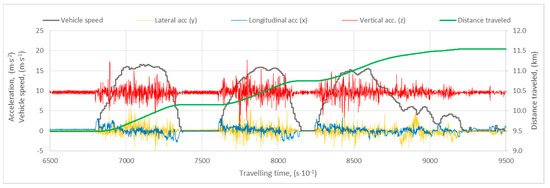
Figure 1.
Graph of vibrations (accelerations) of the vehicle loading space on a selected section of the route covered in 5 min in urban conditions in Lublin (own study).
Of course vibrations occurring during road transport can vary in a very wide spectrum [42,43,44]. The complexity of vibrations of a truck trailer load platform was investigated by Bernard et al., who also shown that not only vertical shakers were required to reproduce vibrations suffered by stacked boxes placed on the trailer platform [43]. That demonstrated the necessity of multi-axis testing with the use of nonvertical random excitations by means of a multi-axis shaker table. Such a method would certainly be more adequate, but it is difficult to access and it is dedicated to testing packaging rather than the durability of the granulate itself. Nevertheless, the cited studies prove the complexity of vibrations occurring in transport and show their differences in relation to the durability test according to the ISO 17831-1 standard where tested pellet is being pouring over inside of a steel rotating container.
The authors tried to meet better conditions for the tests and used methods usually being used in food and feeds testing, which were not widely engaged in pellet investigations but can simulate vertical and lateral transportation loads.
In connection with the above considerations, the aim of the study was to evaluate the durability of selected, commercially available types of pellets made of wood biomass subjected to vertical and horizontal vibrations and then compare the results to obtained with the use of ISO 17831-1 standard procedure.
2. Materials and Methods
2.1. Characteristics of the Research Material
The research material was pellets packed in bags originated from 5 different producers. Each pellet was formed from wood biomass and without additional adhesives had been produced from coniferous trees according to EN ISO 17225-2: 2014-07. For the purposes of this study, the pellets were marked with letters (A, B, C, D, E).
According to the data provided by the producers, all types of pellets had a calorific value of 18.5 MJ·kg−1, maximum moisture content not exceeding 7.5% and ash content below 0.5%. Unfortunately, the exact composition of the pellets could not be established as producers were not willing to disclose such detailed information. On the other hand, it was easy to say that the products obtained for the tests differed in their nominal diameter (6 or 8 mm) and color, which can be seen in the picture (Figure 2) presenting photos of the tested pellets.
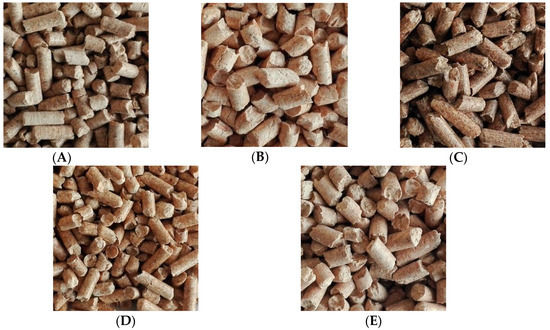
Figure 2.
Tested pellet samples originated from 5 different producers: (A–E) (own study).
Table 1 presents the parameters marked by the producers, which characterize the pellets selected for the tests, such as pellet diameter, moisture content, ash content, calorific value, and the method of packaging. The tested pellets were packed in 15 kg or 25 kg bags. All the parameters were in accordance with the EN 17225: 2014 standard.

Table 1.
Parameters of pellets given by their manufacturers.
2.2. Research Methods
The evaluated pellets had been acquired from local large-area stores. For the purposes of the research, ten packages (bags) of a given type of pellet were purchased. The bags were collected from stacks placed on pallets, selecting packages arranged at different heights of the stack. The purchased material was loaded into the cargo space of a delivery truck and transported to the university’s laboratory rooms, taking care that the activities related to its loading and transport were carried out as delicately as possible. In the laboratory, the pellets were stored in closed packages for several hours at 20 °C. The temperature of 20 °C was selected because that is the average temperature in most rooms where pellets are stored in households.
In order to evaluate the material before further tests and to verify the information provided by pellet producers, measuring points for its main dimensions and moisture tests were performed. Basic measurements of pellet dimensions according to ISO 17829: 2016-02. The pellet moisture content was determined by the drying method at 105 °C, in accordance with ISO 18134-1: 2015-11 (E).
2.3. Mechanical Durability Investigations
The tests of mechanical durability of pellets were carried out using the methods of forced vertical and horizontal oscillations with the use of general purpose laboratory sieve shakers, which are used in research of food products and animal feeds and have not been used in pellet research so far. Additionally, a standardized method dedicated to pellets was also used. The tests were carried out at a room temperature of 20 °C and a laboratory humidity of 40–50%.
For the purpose of the durability tests, samples weighing about 500 g were taken for each of the 10 purchased packages of each type of pellet. The prepared samples were weighed with a laboratory balance at an accuracy of 0.01 g. Then, each sample was subjected to vertical vibrations using a laboratory sieve shaker Retsch AS 200 and a sieve with a hole diameter of 3.15 mm.
The next phase of research was subjecting the samples to horizontal oscillations, set with the use of the SZ-1 laboratory sifter. The method of screening on a sieve with holes of diameter of 3.15 mm was used to assess the damage of pellets. The times of application vertical and horizontal vibrations were 15 min, 30 min, 60 min, and 90 min, which was adopted due to the diversity of transport conditions and the distance at which it could take place.
On the basis of ten repetitions of vertical and horizontal vibration tests, the durability of the pellets was determined for given products. The obtained results were analyzed statistically.
Additionally, for reference purposes, mechanical durability tests were carried out in accordance to EN ISO 17831-1: 2016-02 standard. For the tests, 10 samples of each type of the pellets were prepared. The samples, approximately 500 g each, were successively placed in the rotary tester TG-01 and the durability was determined by sieving the material on a sieve of holes diameter of 3.15 mm.
2.4. Statistical Analysis Methods
To evaluate the differences in the physical properties of the tested pellets, a statistical analysis was performed using the multi-factor ANOVA test. The analyzed dependent variables were the pellet producer and the vibration duration. The analysis also took into account the possibility of interactions between the above-mentioned factors. Statistical analyzes were performed in Dell Statistica version 13.1.
3. Results and Discussion
3.1. Moisture Content in Tested Pellets
The results of measurements of the humidity of the pellets obtained from various producers ranged from 6.8% to 8.92% (Figure 3), which proves that the requirements of the standards were met. According to DIN 51731, the pellet moisture level should be less than 12%, according to ÖNORM M 7135 it should be around 10%, and according to EN ISO 17225-2: 2014-07 it should be no more than 10%.
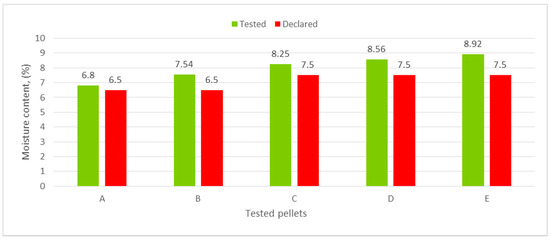
Figure 3.
Comparison of the average moisture content in the samples and values declared by the producers printed on the packaging.
The results of the comparative analysis (Figure 3) show the discrepancy in the moisture content between the measured values and the values declared by the pellet producers and presented on the packages. The declared values are 6.5% for A and B pellets and 7.5% for C, D, and E pellets. The smallest relative difference of the measured value in relation to the declared value was found for A pellets (4.6%), and the highest for E pellets (18.9%). For B, C, and D pellets it was 16.0%, 10.0%, and 14.1%, respectively. It is likely that after the production process the moisture content in the pellets was closer to the declared values. However, it is also possible that the initial stages of storage and distribution, especially in the stores, had already a significant influence on the moisture content of the product and these issues should be considered, too [36,45,46].
However, due to the fact that the measured values of humidity were in accordance with the EN ISO 17225-2: 2014-07 standard, it was assumed that the material was suitable for further durability tests.
3.2. Results of Vertical Vibration Tests
The results of durability tests taking into account vertical vibrations were presented graphically in Figure 4 and Figure 5. The bars show the average values together with the whiskers showing the ranges of the maximum and minimum values.
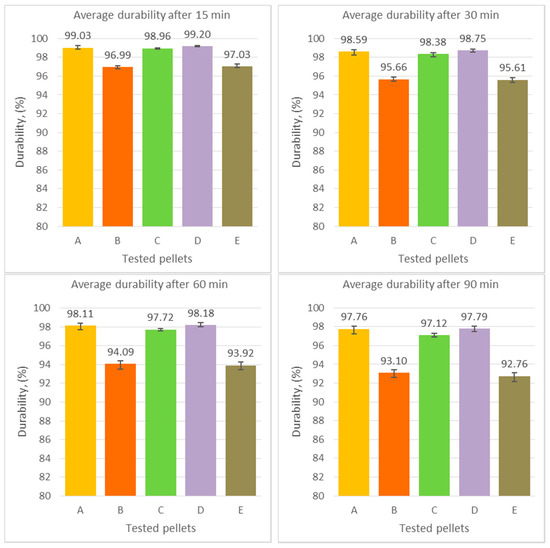
Figure 4.
Results of durability of tested pellets in vertical vibration tests for different duration timing (own study).
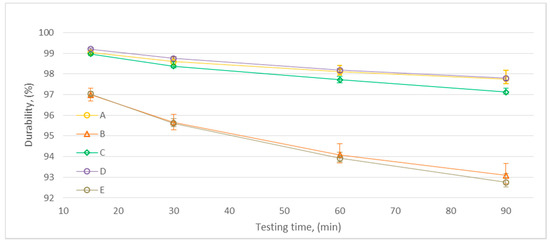
Figure 5.
Influence of vibration timing on durability of tested pellets in vertical vibration tests (own study).
The research results on the durability of pellets subjected to vertical vibrations indicated that wood pellets were diverse in this respect. The D pellets showed the highest durability and the lowest level of crumbs, regardless to the test duration. The resistance to vertical vibrations ranged from 99.20% to 97.79% for the shortest (15 min) and the longest test duration (90 min), respectively. The E pellet was ranked the lowest, reaching 97.03% after 15 min and 92.76% after 90 min of the test. With regard to the tests duration, similar observations were made by Abdulmumini at al., who tested durability using three methods, each of which showed the dependence of the durability results on time [24].
Based on the statistical analysis performed in Dell Statistica version 13.1, it can be concluded that the tested pellets A, B, C, D, and E differed significantly in durability (p < 0.001). Moreover, significant differences in durability were found after different vibration exposure times (p < 0.001), with the pellet weight loss caused by vertical vibrations ranging from 1% to 3% after 30 min, increasing to the level of 2% to 7% after 90 min. The results of the ANOVA test in the case of the analysis of the influence of vertical vibrations on individual types of tested pellets were presented in Table 2.

Table 2.
ANOVA test results for the mass of crumbs due to vertical vibrations.
Figure 5 shows the results obtained for the measured durability as a function of time, which allows to observe trends of changes in time for the tested pellets. Two groups of pellets can be clearly seen. The first group consists of B and E (diameter 8 mm), and the second group includes A, C, and D (diameter 6 mm) pellets. The first group is characterized by a greater mass of defected crumbs as a result of vertical vibrations, which is nearly 3.5 times greater than in the second group.
Based on the analysis set on the multiple comparison test, it was found that there was also a significant statistical difference between the C and D pellets (p = 0.029). It is also worth noting that in the first group, the durability of the pellets decreased faster with the duration of the vibrations. This was confirmed by the ANOVA test, and the interaction between the pellet producer and the exposure time to vertical vibrations was statistically significant (p < 0.001). Interactions between the remaining factors were insignificant.
The observed differentiation in the indicated groups was probably related to the pellets’ diameters, because pellets A, C, and D were pellets with a diameter of 6 mm, while B and E were pellets with a diameter of 8 mm. The raw materials of the pellets were similar (coniferous trees), but the manufacturers did not provide any detailed data according pellets’ composition and used additives, so it was difficult to confirm that relation.
Interesting research on the impact of pellet sizes on the results of standard durability tests was carried out by Gilvari et al. showing, above all, a significant influence of the length of pellets [46].
The authors of this manuscript did not measure the pellet length distribution in the samples, however, they noted that all pellets tested were comparable in terms of length. Pellets A, C, and D were up to 20 mm long, but their average length was about fifteen millimetres. Despite the larger diameter, B and E pellets were also mostly about fifteen millimetres long. Therefore, it was assumed that slight discrepancies in this respect should not significantly affect the durability results.
3.3. Results of Lateral Vibration Tests
The results of the durability tests taking into account horizontal oscillations were presented in the form of bars in the Figure 6 and Figure 7. The results show similar trends that were observed for vertical vibrations.
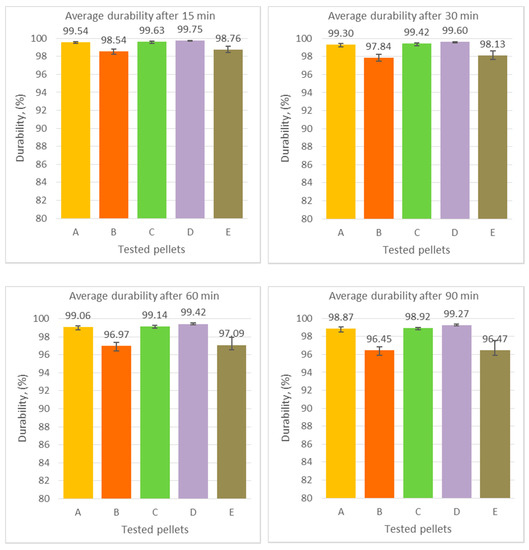
Figure 6.
Results of durability of tested pellets in lateral vibration tests for different duration timing (own study).
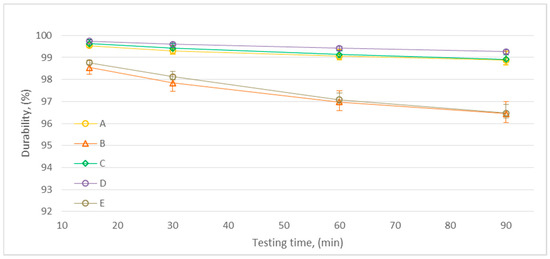
Figure 7.
Influence of timing on durability of tested pellets in lateral vibration tests (own study).
Pellet D showed the highest durability in horizontal oscillation tests. Regardless of the test duration, the results obtained for this pellet were the highest among all the tested. The resistance to horizontal vibrations ranged from 99.75% to 99.27% for the shortest (15 min) and longest test duration (90 min), respectively. Pellet B turned out to be the least durable, reaching 98.54% after 15 min and 96.45% after 90 min of the test. The results for the E pellet were very similar.
Based on the statistical analysis, it can be concluded that the tested pellets A, B, C, D, and E differed significantly in durability (p < 0.001). As in the case of the action of vertical vibrations in the case of horizontal oscillations significant differences in durability were found after different vibration action times (p < 0.001). The pellet weight loss caused by horizontal vibrations fluctuated for pellets of extreme quality within the range of 0.5% and 1.5% after 30 min, increasing to the value of 0.7% and 7% after 90 min, respectively for D and B. The results of the ANOVA test in the case of the analysis of the influence of vertical vibrations on individual types of tested pellets are presented in Table 3.

Table 3.
ANOVA test results for the mass of crumbs due to lateral vibrations.
Figure 7 shows the changes in durability of pellets with the elapsing time of horizontal vibrations. The same two groups can be distinguished as in the case of vertical vibrations. The first are pellets marked with letters B and E, and the second are pellets marked with A, C, and D. Pellets B and E are pellets with a diameter of 8 mm, while A, C, and D are pellets with a diameter of 6 mm.
The first group is characterized by a greater level of crumbs which is about 3.5 times greater than in the second group. Based on the analysis with the multiple comparison test, it was found that there is also a significant statistical difference between the C and D pellets (p = 0.029). In the first group, a higher rate of pellet durability changes was also observed, and was confirmed by the ANOVA test and showed that the interaction between the type of pellet and the duration of the horizontal vibrations is statistically significant (p < 0.001). At the same time, in all cases of pellets, the speed of changes in durability decreases with the duration of the vibration. The presented diagram (Figure 7) shows the changing slope of the curves for given pellets.
Analyzing the results of the research on the impact of vibrations on the pellet quality features, it can be concluded that greater changes in pellet durability occurred during vertical vibrations than as a result of horizontal vibrations. Due to the fact that these methods were not multiaxial tests, as recommended by Bernad [43], their results may not be fully representative for the actual transport loads. However, it can be assumed that they may better match the road loads of pellets than the methodology adopted in the standard.
The study showed that the D pellets showed the greatest durability, both in terms of vertical and horizontal vibrations. The results for A and C pellets were slightly worse. A common feature of these pellets is the diameter of 6 mm. Pellets with the lowest durability are pellets B and E with a diameter of 8 mm, which indicates a potential relationship between the geometric dimensions and the durability of the pellets; however, an unequivocal statement of this relationship would require other tests based on the same pellet material. According to other researchers [46,47,48,49] the durability of biomass pellets depends on various factors, such as the biomass origin (composition), additives, the pre-treatment process, and densification process specifications as well as the length.
In the studies described in this article, the authors did not have detailed information on the composition of the tested granulate. However, the raw material base defined as coniferous wood, and the very similar parameters of pellets declared by the producers (Table 1), allow to assume that the uncertainty of the obtained durability results related to the material composition is not significant. Additionally, it can be noticed that the obtained results served the general evaluation of products available on the market and durability test methods for which they constitute a reference point regardless of their composition.
3.4. Durability Test according to EN ISO 17831
To compare the effectiveness of tests based on vertical vibrations and horizontal oscillations, durability tests were also carried out in accordance to the standard dedicated to pellet tests. The results are presented in Figure 8 as means with the distribution of the maximum and minimum values.
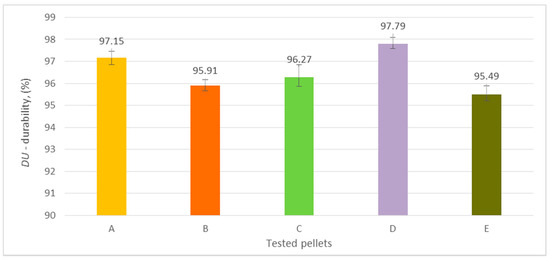
Figure 8.
Durability tests results for tested pellets according to EN ISO 17831 (own study).
The results of the pellet mechanical durability tests (Figure 8) showed that the lowest durability was found for pellets B and E, and the highest for pellets D, as was the case with vertical and horizontal vibrations. The results for the C pellet were slightly different than in the previous tests, which showed relatively lower durability than in the case of vertical and horizontal oscillations. It should be noted that the test in accordance with the EN ISO 17831 standard, despite the fact that it lasted shorter than each of the previously described vibration tests, showed much lower values of the results for individual pellets. This may indicate more destructive nature of the loads applied in the standard procedure.
4. Conclusions
Wood biomass pellets have a very large potential when it comes to combustion in central heating boilers. However, wood biomass pellets sold in chains of large-format stores are characterized by various physical parameters affecting its durability and usability as well as the effectiveness of its use.
Storage and transport conditions may have a significant impact on the quality characteristics of pellets. It was found that the duration of the vibrations, and thus of the transport, significantly influenced the quality characteristics of the pellets.
An attempt to recreate the transport conditions showed that the percentage value of the weight loss of pellets as a result of vertical vibrations for all tested pellets in relation to the loss after 30 min doubled after an additional 60 min, which indicates the need to shorten the routes and thus the duration of transport.
The conducted research also showed that vertical vibrations (AS-200) had a greater impact on the quality of pellets than horizontal vibrations (SZ-1), which was related to the greater mass of the loss observed in the form of crushing.
Durability tests carried out in accordance with the EN ISO 17831 standard dedicated to pellets turned out to be more destructive than vibration tests, which resulted in lower durability values. This can be considered as a confirmation of the effectiveness of the standardized method commonly adopted for pellet testing. However, Gilvari et al. in their work [46] recommended the ISO standard modification according to the pellet length distribution which can also strongly influence the tests results.
It was also observed that the pellets with a larger diameter (8 mm) were characterized by lower durability and greater mass of crushing during the attempts to recreate the transport conditions than the tested pellets with a diameter of 6 mm. However, no unequivocal relationship between the size of the pellet and its strength could be demonstrated, as the exact composition of the tested products was not known.
However, it can be expected that also other types of pellets, apart from the tested in this study, will show a similar weight loss as a function of time, and thus the transport distance. However, it cannot be concluded that the smaller diameter of pellets clearly determines their greater durability. For this purpose, more types of pellets should be tested in relation to the size of the diameter and length.
The obtained test results cannot be generalized to other types and means of pellet transport as the type of transport packaging may have a significant impact on the quality of transported material. It should be assumed that the location of the pellets in the bigbag—the top or the bottom layer—will be important for the pellet damage during transport. However, this kind of research will be done in the future. Moreover, in the described case, only local transport with the use of passenger cars was analyzed and vibration methods were selected for this type of transport. It can be assumed that this type of transport will be realized over short distances. For individual consumers, longer distances and transport times would be uneconomical. At the same time, longer distances mean longer transport time and greater crushing losses, which is observed in the presented research results.
Hence, the research described in this paper can be described as preliminary tests for future studies of other types of transport or the impact of packaging on the quality of the transported pellets, as well as the impact of pellet length on its mechanical durability.
Author Contributions
Conceptualization, A.K., M.S., L.R. and M.P.; methodology, A.K., L.R. and M.P.; investigation, M.S., L.R. and M.P., resources, M.P.; data curation, A.K.; writing—original draft preparation, A.K., M.S. and L.R.; writing—review and editing, A.K. and M.S.; visualization, A.K.; supervision, M.S.; project administration, M.S. All authors have read and agreed to the published version of the manuscript.
Funding
Funded from the ‘Excellent science’ program of the Ministry of Science and Higher Education as a part of the contract no. DNK/SP/465641/2020 “The role of the agricultural engineering and environmental engineering in the sustainable agriculture development”.
Conflicts of Interest
The authors declare no conflict of interest.
References
- José-Vicente, O.-V.; Enrique, G.-A.; Patricia, G.-G. Analysis of durability and dimensional stability of hydrothermal carbonized wooden pellets. Wood Res. 2016, 61, 321–330. [Google Scholar]
- Tabil, L., Jr.; Sokhansanj, S. Process conditions affecting the physical quality of alfalfa pellets. Appl. Eng. Agric. 1996, 12, 345–350. [Google Scholar] [CrossRef]
- Lisowski, A.; Kostrubiec, M.; Dąbrowska-Salwin, M.; Świętochowski, A. Cechy peletów z biomasy roślinnej w aspekcie logistyki dostaw—Features of plant biomass pellets in terms of supply logistics. Logistyka 2015, 5, 351–356. [Google Scholar]
- Zafari, A.; Kianmehr, M.H. Effect of temperature, pressure and moisture content on durability of cattle manure pellet in open-end die method. J. Agric. Sci. 2012, 4, 203–208. [Google Scholar] [CrossRef]
- Colley, Z.; Fasina, O.; Bransby, D.; Lee, Y. Moisture effect on the physical characteristics of switchgrass pellets. Trans. ASABE 2006, 49, 1845–1851. [Google Scholar] [CrossRef]
- Gaze, B.; Noszczyk, T.; Romański, L.; Ufnarski, J. Pelet z torfu jako alternatywne paliwo dla stałych nośników energii- Peat pellets as an alternative fuel for solid energy carriers. Przemysł Chem. 2019, 98, 1069–1074. [Google Scholar]
- Ståhl, M.; Berghel, J.; Williams, H. Energy efficiency, greenhouse gas emissions and durability when using additives in the wood fuel pellet chain. Fuel Process. Technol. 2016, 152, 350–355. [Google Scholar] [CrossRef]
- Whittaker, C.; Shield, I. Factors affecting wood, energy grass and straw pellet durability—A review. Renew. Sustain. Energy Rev. 2017, 71, 1–11. [Google Scholar] [CrossRef]
- Vicente, E.; Vicente, A.; Evtyugina, M.; Tarelho, L.; Almeida, S.; Alves, C. Emissions from residential combustion of certified and uncertified pellets. Renew. Energy 2020, 161, 1059–1071. [Google Scholar] [CrossRef]
- Kalyan, N.; Morey, R. Factors affecting strengh and durability of desified biomass product. Biomass Bioenergy 2009, 33, 337–359. [Google Scholar] [CrossRef]
- Gil Matellanes, M.V.; Oulego Blanco, P.; Casal Banciella, M.D.; Pevida García, C.; Pis Martínez, J.J.; Rubiera González, F. Mechanical durability and combustion characteristics of pellets from biomass blends. Bioresour. Technol. 2010, 101, 8859–8867. [Google Scholar]
- Larsson, S.H.; Rudolfsson, M.; Nordwaeger, M.; Olofsson, I.; Samuelsson, R. Effects of moisture content, torrefaction temperature, and die temperature in pilot scale pelletizing of torrefied Norway spruce. Appl. Energy 2013, 102, 827–832. [Google Scholar] [CrossRef]
- Järvinen, T.; Agar, D. Experimentally determined storage and handling properties of fuel pellets made from torrefied whole-tree pine chips, logging residues and beech stem wood. Fuel 2014, 129, 330–339. [Google Scholar] [CrossRef]
- Arranz, J.; Miranda, M.; Montero, I.; Sepúlveda, F.; Rojas, C. Characterization and combustion behaviour of commercial and experimental wood pellets in South West Europe. Fuel 2015, 142, 199–207. [Google Scholar] [CrossRef]
- Rudolfsson, M.; Borén, E.; Pommer, L.; Nordin, A.; Lestander, T.A. Combined effects of torrefaction and pelletization parameters on the quality of pellets produced from torrefied biomass. Appl. Energy 2017, 191, 414–424. [Google Scholar] [CrossRef]
- Agar, D.A.; Rudolfsson, M.; Kalén, G.; Campargue, M.; Da Silva Perez, D.; Larsson, S.H. A systematic study of ring-die pellet production from forest and agricultural biomass. Fuel Process. Technol. 2018, 180, 47–55. [Google Scholar] [CrossRef]
- Riva, L.; Nielsen, H.K.; Skreiberg, Ø.; Wang, L.; Bartocci, P.; Barbanera, M.; Bidini, G.; Fantozzi, F. Analysis of optimal temperature, pressure and binder quantity for the production of biocarbon pellet to be used as a substitute for coke. Appl. Energy 2019, 256, 113933. [Google Scholar] [CrossRef]
- Carroll, J.P.; Finnan, J. Physical and chemical properties of pellets from energy crops and cereal straws. Biosyst. Eng. 2012, 112, 151–159. [Google Scholar] [CrossRef]
- Williams, O.; Lester, E.; Kingman, S.; Giddings, D.; Lormor, S.; Eastwick, C. Benefits of dry comminution of biomass pellets in a knife mill. Biosyst. Eng. 2017, 160, 42–54. [Google Scholar] [CrossRef]
- Lehtikangas, P. Quality properties of pelletised sawdust, logging residues and bark. Biomass Bioenergy 2001, 20, 351–360. [Google Scholar] [CrossRef]
- Ahn, B.J.; Chang, H.; Lee, S.M.; Choi, D.H.; Cho, S.T.; Han, G.; Yang, I. Effect of binders on the durability of wood pellets fabricated from Larix kaemferi C. and Liriodendron tulipifera L. sawdust. Renew. Energy 2014, 62, 18–23. [Google Scholar] [CrossRef]
- Graham, S.; Ogunfayo, I.; Hall, M.R.; Snape, C.; Quick, W.; Weatherstone, S.; Eastwick, C. Changes in mechanical properties of wood pellets during artificial degradation in a laboratory environment. Fuel Process. Technol. 2016, 148, 395–402. [Google Scholar] [CrossRef]
- Temmerman, M.; Rabier, F.; Jensen, P.D.; Hartmann, H.; Böhm, T. Comparative study of durability test methods for pellets and briquettes. Biomass Bioenergy 2006, 30, 964–972. [Google Scholar] [CrossRef]
- Abdulmumini, M.M.; Zigan, S.; Bradley, M.S.A.; Lestander, T.A. Fuel pellet breakage in pneumatic transport and durability tests. Renew. Energy 2020, 157, 911–919. [Google Scholar] [CrossRef]
- Saidur, R.; Abdelaziz, E.A.; Demirbas, A.; Hossain, M.S.; Mekhilef, S. A review on biomass as a fuel for boilers. Renew. Sustain. Energy Rev. 2011, 15, 2262–2289. [Google Scholar] [CrossRef]
- Anukam, A.I.; Berghel, J.; Frodeson, S.; Famewo, E.B.; Nyamukamba, P. Characterization of Pure and Blended Pellets Made from Norway Spruce and Pea Starch: A Comparative Study of Bonding Mechanism Relevant to Quality. Energies 2019, 12, 4415. [Google Scholar] [CrossRef]
- Anukam, A.; Mamphweli, S.; Reddy, P.; Meyer, E.; Okoh, O. Pre-processing of sugarcane bagasse for gasification in a downdraft biomass gasifier system: A comprehensive review. Renew. Sustain. Energy Rev. 2016, 66, 775–801. [Google Scholar] [CrossRef]
- Ioelovich, M. High-Energy Fuel Pellets. SciEnvironm 2020, 3, 147–152. [Google Scholar]
- Svedberg, U.; Samuelsson, J.; Melin, S. Hazardous Off-Gassing of Carbon Monoxide and Oxygen Depletion during Ocean Transportation of Wood Pellets. Ann. Occup. Hyg. 2008, 52, 259–266. [Google Scholar] [CrossRef]
- Selkimäki, M.; Mola-Yudego, B.; Röser, D.; Prinz, R.; Sikanen, L. Present and future trends in pellet markets, raw materials, and supply logistics in Sweden and Finland. Renew. Sustain. Energy Rev. 2010, 14, 3068–3075. [Google Scholar] [CrossRef]
- Pirraglia, A.; Gonzalez, R.; Saloni, D.; Wright, J. Wood pellets: An expanding market opportunity. Biomass Mag. 2010, 6, 68–75. [Google Scholar]
- Thomson, H.; Liddell, C. The suitability of wood pellet heating for domestic households: A review of literature. Renew. Sustain. Energy Rev. 2015, 42, 1362–1369. [Google Scholar] [CrossRef]
- Rominiyi, O.L.; Adaramola, B.A.; Ikumapayi, O.M.; Oginni, O.T.; Akinola, S.A. Potential Utilization of Sawdust in Energy, Manufacturing and Agricultural Industry; Waste to Wealth. World J. Eng. Technol. 2017, 5, 526–539. [Google Scholar] [CrossRef]
- Abadi, M.H.M.G.; Moravej, H.; Shivazad, M.; Torshizi, M.A.K.; Kim, W.K. Effect of different types and levels of fat addition and pellet binders on physical pellet quality of broiler feeds. Poult. Sci. 2019, 98, 4745–4754. [Google Scholar] [CrossRef] [PubMed]
- Bradfield, J.; Levi, M. Effect of species and wood to bark ratio on pelleting of southern woods. For. Prod. J. 1984, 34, 61–63. [Google Scholar]
- Rynkiewicz, M.; Dobek, T.K. Wybrane właściwości fizyczne i mechaniczne peletów w zależności od składu i temperatury ich przechowywania—Selected physical and mechanical properties of pellets depending on the composition and temperature of their storage. Inżynieria Rol. Agric. Eng. 2013, 3, 321–330. [Google Scholar]
- Sławiński, K.; Zdanowicz, A. Techniki transportu drogowego pelletu—Pellet road transport techniques. Autobusy Tech. Eksploat. Syst. Transp. 2016, 17, 240–244. [Google Scholar]
- Searcy, E.; Hess, J.R.; Tumuluru, J.; Ovard, L.; Muth, D.J.; Trømborg, E.; Wild, M.; Deutmeyer, M.; Nikolaisen, L.; Ranta, T.; et al. Optimization of Biomass Transport and Logistics. In International Bioenergy Trade: History, Status & Outlook on Securing Sustainable Bioenergy Supply, Demand and Markets; Lecture Notes in Energy; Junginger, M., Goh, C.S., Faaij, A., Eds.; Springer: Dordrecht, The Netherlands, 2014; pp. 103–123. ISBN 978-94-007-6982-3. [Google Scholar]
- Lacoa, U.; Velarde, G.; Kay, M.; Blanco, E.; Saloni, D.E. Design and Development of Logistics Models for Residential and Commercial Biomass Pellets for Heat and Power Generation in the U.S. BioResources 2017, 12, 1506–1531. [Google Scholar] [CrossRef]
- Khatwani, P.A.; Nag, S. Review on the Study of structure of Polypropylene for development of different textile based products for packaging industries. Int. J. Res. Anal. Rev. 2018, 6, 4. [Google Scholar]
- Qian, Y.; McDow, W. The Wood Pellet Value Chain; US Endowment for Forestry and Communities: Greenville, SC, USA, 2013; Volume 59. [Google Scholar]
- Lu, F.; Ishikawa, Y.; Shiina, T.; Satake, T. Analysis of shock and vibration in truck transport in Japan. Packag. Technol. Sci. 2008, 21, 479–489. [Google Scholar] [CrossRef]
- Bernad, C.; Laspalas, A.; González, D.; Núñez, J.L.; Buil, F. Transport vibration laboratory simulation: On the necessity of multiaxis testing. Packag. Technol. Sci. 2011, 24, 1–14. [Google Scholar] [CrossRef]
- Chonhenchob, V.; Singh, S.P.; Singh, J.J.; Stallings, J.; Grewal, G. Measurement and Analysis of Vehicle Vibration for Delivering Packages in Small-Sized and Medium-Sized Trucks and Automobiles. Packag. Technol. Sci. 2012, 25, 31–38. [Google Scholar] [CrossRef]
- Graham, S.; Eastwick, C.; Snape, C.; Quick, W. Mechanical degradation of biomass wood pellets during long term stockpile storage. Fuel Process. Technol. 2017, 160, 143–151. [Google Scholar] [CrossRef]
- Gilvari, H.; De Jong, W.; Schott, D.L. The Effect of Biomass Pellet Length, Test Conditions and Torrefaction on Mechanical Durability Characteristics According to ISO Standard 17831-1. Energies 2020, 13, 3000. [Google Scholar] [CrossRef]
- Tang, Y.; Chandra, R.P.; Sokhansanj, S.; Saddler, J.N. The role of biomass composition and steam treatment on durability of pellets. BioEnergy Res. 2018, 11, 341–350. [Google Scholar] [CrossRef]
- Serrano, C.; Monedero, E.; Lapuerta, M.; Portero, H. Effect of moisture content, particle size and pine addition on quality parameters of barley straw pellets. Fuel Process. Technol. 2011, 92, 699–706. [Google Scholar] [CrossRef]
- Chico-Santamarta, L.; Chaney, K.; Godwin, R.J.; White, D.R.; Humphries, A.C. Physical quality changes during the storage of canola (Brassica napus L.) straw pellets. Appl. Energy 2012, 95, 220–226. [Google Scholar] [CrossRef]
Publisher’s Note: MDPI stays neutral with regard to jurisdictional claims in published maps and institutional affiliations. |
© 2020 by the authors. Licensee MDPI, Basel, Switzerland. This article is an open access article distributed under the terms and conditions of the Creative Commons Attribution (CC BY) license (http://creativecommons.org/licenses/by/4.0/).